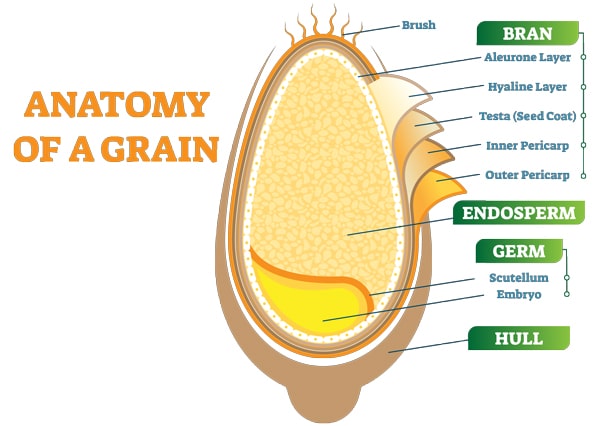Did you know that grains are not a necessary part of the equine diet? Horses are grazing animals; this means that they have evolved to trickle feed on forage. However, just because grains are not required does not mean there isn’t a time and place for them in equine nutrition.
Grain-free diets are gaining popularity in the equine industry; surely you have seen it mentioned on equine social media pages. So what is a grain-free diet? Well, to break it down, let’s start with defining a grain.
What is a grain?
Many horse owners may be confused when grain-free is discussed, as it is a common misconception that anything pelleted or processed is a grain, or contains grains. This is not necessarily true. A grain is a seed produced from a cereal crop. This includes oats, barley, corn, and wheat, to list a few. The grain of these plants has four distinct parts to them: the germ, the endosperm, the bran and the hull. This is important when we discuss how feeds are classified.

(Adobestock.com)
The endosperm is the largest portion of the grain and contains carbohydrates, proteins, vitamins, and minerals. The germ (also known as the embryo) contains vitamins, some protein, minerals, and fats. Both the hull and the bran are rich in fiber, so these parts are commonly found in equine feeds.
The Association of American Feed Control Officials defines grain as “a seed from cereal plants.” Therefore, even though a feed may not contain the whole seed from that cereal plant, it can contain the parts such as the hull and still be technically classified as “grain-free.” Confusing, right?!
So to reiterate: if a product is labelled as “grain-free” it may still contain various parts of the grain. But is this a bad thing?
Well, the different parts of the grain have varying nutritional properties. Most of the reasoning behind “grain-free” is that horse owners want to decrease the starch content of their horse’s diet, as high levels can cause gastric ulcers, insulin resistance, laminitis and tying up. But when just the fibre-rich hull is used, there isn’t a significant amount of starch added. Some owners may also choose to go grain-free to alleviate an allergy or combat digestive issues in their horse.
There are many commercial products that are specifically designed and marketed for insulin-resistant horses or horses with metabolic issues that contain grain by-products. Next time you’re at the feed store, read the ingredient list on the labels and see for yourself. And if you’re comparing various products at a feed store, don’t shy away from something simply because it contains oat hulls, for example.
A large proportion of horses can be maintained perfectly well on forage and a ration balancer. So instead of having a significant focus on grain-free, why don’t we shift that focus to ‘forage-based with reduced starch content’?
Know What’s in Your Hay
For most horses, long-stem fibre (grass and hay) makes up the majority of their diet. Grains originally began being fed to horses to meet their increased nutrient requirements when working. With scientific and technological advancements there are a plethora of options when looking to increase the digestible energy content in the diet. However, forage should still be the base of the diet.
For every horse, a diet balancing their energy, protein, vitamin, and mineral requirements is crucial, whether it is grain-free or not. This is where testing your forage comes into play. Due to the significant amount of forage a horse consumes, knowing the nutritional content is essential.
Once you have this base information it is much easier to make informed decisions on whether a grain-free diet is suitable for your horse. Knowing the energy and protein content of your forage will inform you if a simple ration balancer is required, or if your horse needs a bit more.
Although grain-free is a hot topic right now, having a diet that incorporates grains and meets the horse’s nutritional requirements is preferred to employing grain-free, but having nutrient deficiencies.

